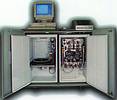

* An East Coast steel works suffers a significant loss of nitrifiers in their biomass due to an abrupt change in the coke plant's wastewater toxicity.
* A California petroleum refinery is faced with the challenge of determining the required amount of treatment necessary to maintain compliance with federally mandated toxicity discharge limits.
* A European wastewater treatment plant fails to divert a highly toxic influent before it enters the plant's system, thereby suffering a loss in its biomass.
Each of these situations could lead to severe environmental, regulatory or economic problems if not caught in time. And the damage to public confidence can last long after the physical damage is corrected.
The Microtox-OS Test System from Siemens Environmental Systems is claimed to be the first continuous water quality monitor that warns the user within minutes of contamination from organic, inorganic, heavy metals and other compounds. The system continuously monitors the industrial influent or process streams, providing the earliest available warning of contamination.
As often as every 20 minutes, day and night, the system can remotely monitor influent or effluent water quality with unerring precision. It is an effective early warning system for water regulators, wastewater plant managers and industrial process engineers, alerting them to the presence of toxic compounds. Facility personnel using the Microtox-OS Test System are able to quickly identify, diagnose and take corrective measures.
The Microtox-OS Test System was developed in response to the needs of Yorkshire Water, a major UK water utility. Yorkshire Water conducted an extensive study to determine how to properly manage acute toxic events associated with sewage and industrial effluent entering its treatment works. They did so in order to protect against toxic discharges and to protect treatment plant biomass.
The results of Yorkshire Water's study indicated that conventional laboratory techniques such as respirometry and chemical oxygen demand (COD) testing are unable to provide sufficient warning of toxic discharge before it can pass through a treatment plant and into the environment. They concluded that the preferred solution is continuous toxicity monitoring with the Microtox-OS Test System.
When potential disaster is flowing downstream, speed is essential. The Microtox-OS Test System provides rapid testing and results to ensure that the chances of contamination going undetected are significantly reduced.
With testing as frequently as every 20 minutes, the user receives feedback on the quality of the process stream, influent or effluent water up to 72 times per day. The Test System gives a critical reaction-time advantage in order to take preventative action to divert toxic flow or confine it into a safe holding area. With other methods, by the time results are available, it may be too late to avert damage.
Whether sample-monitoring sites are a short distance away or 20 miles upstream, the system is fully automated. The user does not have to waste valuable resources and unproductive travel time setting up daily chemical specific or biological assays, as he can locate test sites farther away from the plant to give more time to react.
The Microtox-OS Test System brings AZUR's patented and validated technology into a completely automated system. Vials of freeze-dried reagent are diluted and reconstituted and a prepared sample is then exposed to the water source to be tested. A high sensitivity detector measures the light loss in the prepared sample, compared to a control sample, and the data is then logged into the system's memory.
The instrument's rotating carousel holds 36 vials of reagent, each of which supplies up to 30 tests. It can operate completely unattended on a full 14-day schedule and up to 17 days if necessary. A fresh vial of reagent is automatically reconstituted every 12 hours, regardless of the testing interval, to assure that test reagents are at the optimal performance level
Automated safeguards ensure the quality of the reagents. A standard is tested at user-set intervals as a quality control check. Back-up vials of reagent are included in each carousel in the event that they are needed.
Time can be saved by remotely adjusting system parameters such as sample intervals and toxicity alarm settings via the host computer at the plant. The test system also offers connection flexibility to the plant's scada system.

© Technews Publishing (Pty) Ltd | All Rights Reserved